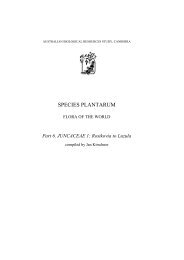Introduction - Species Plantarum Programme
Introduction - Species Plantarum Programme
Introduction - Species Plantarum Programme
You also want an ePaper? Increase the reach of your titles
YUMPU automatically turns print PDFs into web optimized ePapers that Google loves.
4<br />
SPECIES PLANTARUM — FLORA OF THE WORLD (1999)<br />
• It was agreed that the project would develop both a traditional printed Flora and an<br />
electronic database simultaneously.<br />
• At least one major family treatment (Juncaceae; c. 10 genera, 325 species) was noted as<br />
being in preparation for <strong>Species</strong> <strong>Plantarum</strong> by a consortium of international botanists, and<br />
the Steering Committee identified a number of others which could be developed quickly.<br />
• Two draft family treatments, Irvingiaceae (David Harris) and Morinaceae (M.J &<br />
J.F.M.Cannon) were tabled. It was agreed that these provided excellent models for the<br />
printed Flora, should be published as soon as possible, and be widely distributed.<br />
• The Australian Biological Resources Study (Environment Australia, Canberra) was<br />
invited to act as editing coordinator and publisher of the printed version of <strong>Species</strong><br />
<strong>Plantarum</strong>. Format was to follow, in general, Flora of Australia, with minor modifications as<br />
agreed. Publication would be in self-contained fascicles, each covering a family, subfamily<br />
or other large contiguous group (e.g. a large genus or group of related genera).<br />
• It was agreed that the vehicle for electronic publication should be the Global Plant<br />
Checklist of the International Organisation for Plant Information (IOPI). In the first instance<br />
information on names, bibliographic information, type information, and distributional<br />
information will be passed from the printed version of the Flora to the compilers of the IOPI<br />
Checklist project. Descriptive information and miscellaneous notes, which present major<br />
difficulties in development of a protocol and format, will not be databased initially, but may<br />
be added later.<br />
• It was agreed that <strong>Species</strong> <strong>Plantarum</strong> had to be an international project not just in name,<br />
but in its writing and publication as well. It provides an ideal vehicle for capacity-building in<br />
taxonomy, and every effort should be made to involve young taxonomists, particularly from<br />
developing countries, in all aspects of the project.<br />
The way forward<br />
This introduction contains materials necessary to guide potential contributors in the<br />
preparation of <strong>Species</strong> <strong>Plantarum</strong> treatments, and to provide general information for users. It<br />
consists of a Guide for Contributors, Glossary, a list of Abbreviations and Contractions,<br />
explanation of the 'Country' abbreviations used to describe distribution, and maps showing<br />
the extent and location of those 'Countries'. As some of these instructions may change over<br />
time, they will also be available in regularly updated form on the World Wide Web, via the<br />
ABRS homepage (currently http://www.anbg.gov.au/abrs/), and the IOPI homepage<br />
(currently http://life.csu.edu.au/iopi/iopihome.html).<br />
The Guide for Contributors will be translated into a number of other languages for ease of<br />
use, although the language of <strong>Species</strong> <strong>Plantarum</strong> will be English.<br />
The Priorities and Contributors Subcommittee of <strong>Species</strong> <strong>Plantarum</strong> will be primarily<br />
responsible for recruitment and coordination of authors of particular groups, but volunteers<br />
are invited to contact any member of the Steering Committee with offers to contribute. It is<br />
intended that parts will be published in the order completed, and will each contain a family,<br />
subfamily or other group of related taxa. With the exception of small families, it is intended<br />
that individual parts will contain a minimum of 50 to 100 species.<br />
Contributions will provide descriptions of taxa from family to infra-specific ranks,<br />
synonymy, classification, keys for identification at all intermediate levels, illustrations,<br />
maps, and brief discussions of biology, biogeography and variability. All validly published names<br />
will be accounted for either as accepted names, synonyms or names of uncertain application,<br />
and bibliographic details and typification for each name will be provided.












